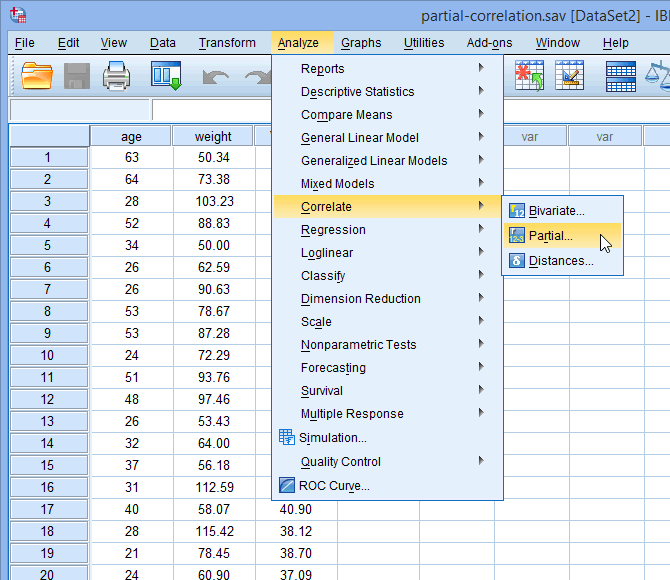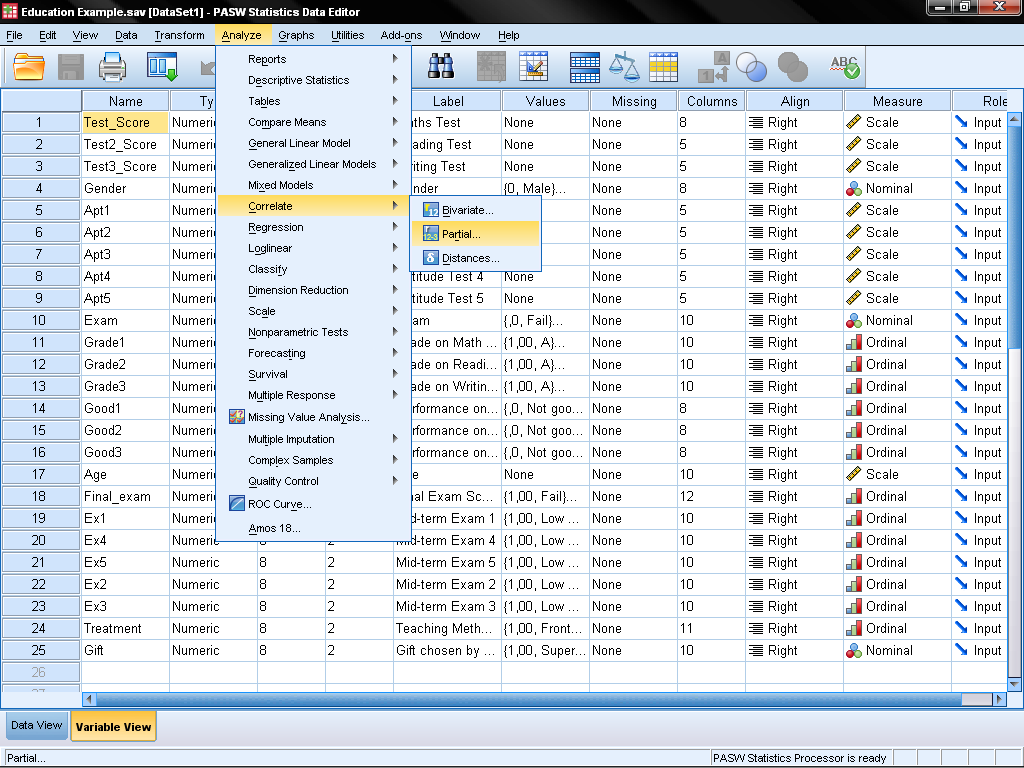
V13.6 SemiPartial Correlation (Type B) in SPSS YouTube
In probability theory and statistics, partial correlation measures the degree of association between two random variables, with the effect of a set of controlling random variables removed.

Partial Correlation in SPSS Statistics Procedure, assumptions, and output using a relevant
Partial Correlations Options Statistics. You can choose one or both of the following: Means and standard deviations. Displayed for each variable. The number of cases with nonmissing values is also shown. Zero-order correlations. A matrix of simple correlations between all variables, including control variables, is displayed. Missing Values.

Partial correlation in SPSS YouTube
Partial correlations are great in that you can perform a correlation between two continuous variables whilst controlling for various confounders. However, the partial correlation option in SPSS is defaulted to performing a Pearson's partial correlation which assumes normality of the two variables of interest.

Advanced Stats with SPSS Partial correlation
How to Calculate Partial Correlation in SPSS In statistics, we often use the Pearson correlation coefficient to measure the linear relationship between two variables. However, sometimes we're interested in understanding the relationship between two variables while controlling for a third variable.

Partial Correlation in SPSS Dr. Matt C. Howard
Partial correlation can be explained as the association between two random variables after eliminating the effect of another or several other variables. It is a useful measurement in the presence of confounding. Similar to the Pearson correlation coefficient, partial correlation coefficient is also a dimensionless quantity ranging between -1 and 1.

V13.3 Partial Correlation in SPSS YouTube
Introduction Partial correlation is a measure of the strength and direction of a linear relationship between two continuous variables whilst controlling for the effect of one or more other continuous variables (also known as 'covariates' or 'control' variables).

How to Calculate Partial Correlation in SPSS Statology
Partial correlations are computed by partialing out the impact of extraneous variables on the association between two or more variables. In this video, I dem.

r Partial correlation plot, split by groups SPSS Cross Validated
Partial Correlations The Partial Correlations procedure computes partial correlation coefficients that describe the linear relationship between two variables while controlling for the effects of one or more additional variables. All the variables should be scale variables. Next Using Partial Correlations to Unravel "Relationships"

Understanding zero order, partial, and part correlations in your SPSS regression output (July
Answer. SPSS does not currently have a procedure that explicitly saves a matrix file containing partial correlations, but it is reasonably simple to produce such a file. The partial correlations between variables controlling for other variables are equal to the bivariate or zero-order correlations of the residuals of the variables from.

Partial correlation in SPSS YouTube
In this video, I demonstrate how to perform and interpret a partial correlation in SPSS. I also demonstrate how to create a scatter plot for a partial correl.

How to do Partial Correlation using SPSS? G N Satish Kumar YouTube
Partial Correlation in SPSS (SPSS Tutorial Video #16) Data Demystified 16.8K subscribers 1.1K views 2 years ago SPSS Tutorials In this video, I cover the details of how how to conduct and.

SPSS Tutorial Partial Correlation YouTube
Partial correlation measures the strength of a relationship between two variables, while controlling for the effect of one or more other variables. For example, you might want to see if there is a correlation between amount of food eaten and blood pressure, while controlling for weight or amount of exercise.

Testing the Assumptions for Partial Correlation in SPSS YouTube
This video demonstrates how to calculate and interpret partial correlations in SPSS. Partial correlations can indicate an association between two variables w.

Conduct and Interpret a Partial Correlation Statistics Solutions
Partial correlation is the statistical test to identify and correct spurious correlations. How to run the Partial Correlation in SPSS In our education example, we find that the test scores of the second and the fifth aptitude tests positively correlate.

SPSS (14) Correlation Estimation II (Partial Correlation) YouTube
Overview. Partial and semipartial correlations provide another means of assessing the relative "importance" of independent variables in determining Y. Basically, they show how much each variable uniquely contributes to R2 over and above that which can be accounted for by the other IVs.

Partial correlation presentation and tutorial in SPSS YouTube
The Partial correlations procedure computes partial correlation coefficients that describe the linear relationship between two variables while controlling for the effects of one or more additional variables. Correlations are measures of linear association.